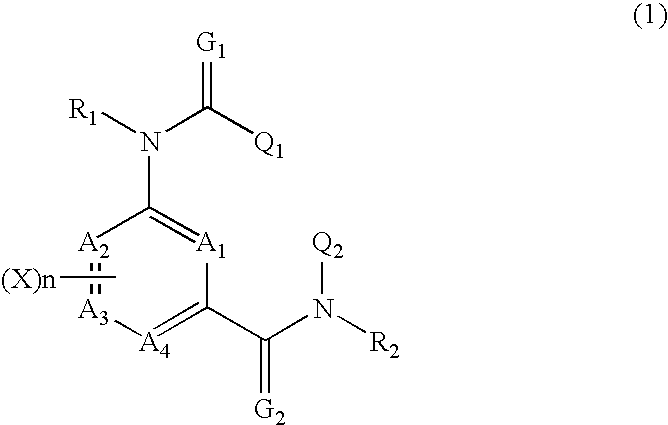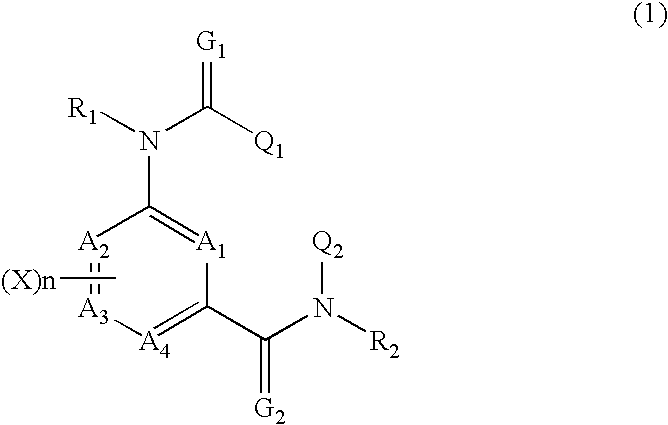Composition for preventing harmful organisms
a technology for harmful organisms and compositions, applied in the field of compositions for preventing harmful organisms, can solve the problems of difficult control and inability to control harmful organisms, and achieve the effects of labor saving, remarkable control effect, and remarkable control
- Summary
- Abstract
- Description
- Claims
- Application Information
AI Technical Summary
Benefits of technology
Problems solved by technology
Method used
Image
Examples
example 1-1
Preparation of N-(2,6-dimethyl-4-heptafluoroisopropyl)phenyl 3-nitrobenzamide
[0290]To a solution of 20.0 g of 2,6-dimethyl-4-heptafluoroisopropylaniline and 11.0 g of pyridine added to 100 ml of tetrahydrofuran and stirred at room temperature was introduced dropwise 13.0 g of 3-nitrobenzoyl chloride dissolved in 20 ml of tetrahydrofuran little by little. The reaction solution was stirred at room temperature for 10 hours, and then ethyl acetate and water were added thereto. Solution separation was performed for taking out an organic layer. The organic layer was dried over anhydrous magnesium sulfate. The solution was filtered off, the filtrate was collected, and the solvent was removed under a reduced pressure to obtain a residue. The resulting residue was washed with a mixed solvent of hexane and diisopropyl ether to obtain 26.0 g of the desired product (Yield: 85%) as a white solid.
[0291]1H-NMR (CDCl3, ppm) δ 2.33 (6H, s), 7.37 (2H, s), 7.68 (1H, s), 7.72 (1H, t, J=8.1 Hz), 8.28 (1...
example 1-2
Preparation of N-(2,6-dimethyl-4-heptafluoroisopropyl)phenyl 3-aminobenzamide
[0292]To a solution of 0.90 g of N-(2,6-dimethyl-4-heptafluoroisopropyl)phenyl 3-nitrobenzamide and 1.56 g of anhydrous stannous chloride added to 25 ml of ethanol and stirred at room temperature was added 2 ml of concentrated hydrochloric acid, and the resulting mixture was stirred at 60 degree centigrade for 1 hour. The reaction solution was returned to room temperature, poured into water, and then neutralized with potassium carbonate. Ethyl acetate was added thereto, the insoluble substance was filtered off, and then the organic layer was separated and dried over anhydrous magnesium sulfate. The solution was filtered off, the filtrate was collected, and the solvent was removed under a reduced pressure to obtain a residue. The resulting residue was washed with hexane to obtain 0.44 g of the desired product (Yield: 53%) as a white solid.
[0293]1H-NMR (CDCl3, ppm) δ 2.34 (6H, s), 3.87 (2H, broad), 6.86-6.89 ...
example 1-3
Preparation of N-(2,6-dimethyl-4-heptafluoroisopropyl)phenyl 3-(benzoylamino)benzamide (Compound No. 10)
[0294]To a solution of 0.25 g of N-(2,6-dimethyl-4-heptafluoroisopropyl)phenyl 3-aminobenzamide and 0.06 g of pyridine added to 5 ml of tetrahydrofuran and stirred at room temperature was introduced dropwise 0.09 g of benzoyl chloride dissolved in 1 ml of tetrahydrofuran. The reaction solution was stirred at room temperature for 1 hour, and then ethyl acetate and 1N hydrochloric acid were added thereto for separating an organic layer. The organic layer was washed with saturated baking soda solution one time and then dried over anhydrous magnesium sulfate. The solution was filtered off, the filtrate was collected and the solvent was removed under a reduced pressure to precipitate a solid. The precipitated solid was washed with diisopropyl ether to obtain 0.29 g of the desired product (Yield: 92%) as a white solid.
[0295]1H-NMR (DMSO-d6, ppm) δ2.37 (6H, s), 7.34 (2H, s), 7.46-7.57 (4...
PUM
| Property | Measurement | Unit |
|---|---|---|
| weight | aaaaa | aaaaa |
Abstract
Description
Claims
Application Information
 Login to View More
Login to View More - R&D
- Intellectual Property
- Life Sciences
- Materials
- Tech Scout
- Unparalleled Data Quality
- Higher Quality Content
- 60% Fewer Hallucinations
Browse by: Latest US Patents, China's latest patents, Technical Efficacy Thesaurus, Application Domain, Technology Topic, Popular Technical Reports.
© 2025 PatSnap. All rights reserved.Legal|Privacy policy|Modern Slavery Act Transparency Statement|Sitemap|About US| Contact US: help@patsnap.com



